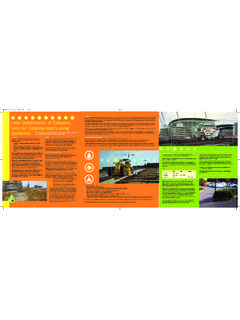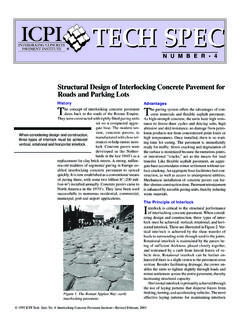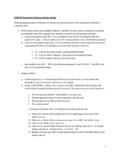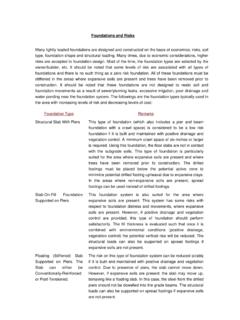Transcription of The Use of Geocells in Road Constructions Over …
1 EuroGeo4 Paper number 132 1 THE USE OF Geocells IN road Constructions over SOFT SOIL: VERTICAL STRESS and falling weight deflectometer measurements Ansgar Emersleben1 & Norbert Meyer2 1 Institute of Geotechnical Engineering, Technology University of Clausthal. (e-mail: 2 Institute of Geotechnical Engineering, Technology University of Clausthal. (e-mail: Abstract: Geocells consist of a series of interconnected single cells that are manufactured from different types of polymers. The Geocells are expanded at the construction site and filled with soil. The cell walls completely encase the infill material and provide all-round confinement to the soil. During vertical loading, hoop stresses within the cell walls and earth resistance in the adjacent cells are mobilized which increases the stiffness and the load-deformation behaviour of the soil.))
2 Thus the soil-geocell layers acts as a stiff mat and distribute the vertical traffic loads over a much larger area of the subgrade soil. Large scale static load tests were carried out to evaluate the influence of a geocell layer on the load-deformation behaviour of the soil. The test results show that a geocell layer increases the bearing capacity of the infill materials up to three times compared to an unreinforced soil. The vertical stresses on the soft subgrade, measured by eight earth pressure cells, where also reduced about 30 percent. To verify the results of model tests in-situ field test where carried out within different road Constructions . Earth pressure cells where installed on the subgrade to measure the influence of the geocell layers on the stress distribution.
3 After finishing the road construction vehicle crossing tests with a 40-ton truck were carried out while the stresses on the subgrade where measured. Compared to an unreinforced test section the stresses beneath the geocell layer were reduced by about 30 percent. In addition to vertical stress measurements, falling weight deflectometer (FWD) measurements were conducted in reinforced and unreinforced test sections. The results show that the deflections measured in geocell reinforced test section were significantly smaller than in the unreinforced section. Back calculated layer modules were significantly higher in the geocell reinforced section compared to an unreinforced section. Keywords: geocell, cellular system, earth reinforcement, field measurement , soil improvement, load tests INTRODUCTION Geocells are honeycomb interconnected cells that completely encase the soil and provide all-around confinement, thus preventing the lateral spreading of the infill material.
4 Due to the confinement of the soil the Geocells increase the stiffness and the load-deformation behaviour of gravel base layers and thereby reduce the deformation of the soil. The soil-geocell layers act as a stiff mat, thus distributing the vertical traffic loads over a much larger area of the subgrade soil. Several model tests ( Dash et al. 2001, 2003, Sitharam &Siressh 2005) have shown the positive effect of Geocells , made from different geogrids, on the load bearing capacity of soils. Meyer & Emersleben (2005a, 2005b, 2005c, 2006a, 2006b) and Mhaiskar & Mandal (1992) have evaluated the influence of industrially manufactured Geocells on the load-deformation behaviour of soils. The use of Geocells to stabilize unpaved road Constructions is far from common, especially if suitable soils are not available near the construction site (Ben Kurari 2000, Forsman et al.)
5 1998, Leytland et al. 2006). The stabilization of gravel base layers of asphalt paved road Constructions over soft soils with Geocells is an alternative technique to reduce the deformation of the asphalt surface and to increase the stiffness of the main construction . Al Quadi & Hughes (2000) reported an increase of the resilient modules of aggregate layers about two times due to the installation of Geocells within an asphalt paved road construction . This paper reports the results of static load tests and in in-situ field tests. By means of vertical stress measurements beneath the geocell layers and by means of falling weight deflectometer (FWD) measurements in geocell reinforced test fields the positive influence of Geocells was evaluated.
6 LARGE SCALE MODEL TESTS Test Device To evaluate the influence of Geocells on the load bearing capacity of soil and the stress distribution large scale model tests were carried out in a test box with internal dimensions of 2m length, 2m width and 2m height. Static load is applied over a loading frame, and vertical loads up to 150 kN can be applied. The loads are applied by a hydraulic jack and are transferred by a steel plate with a diameter of 30 cm to the soil. To measure the heave and settlement on the soil surface five inductive displacement gauges were installed at different distances from the centre of the load plate. For the determination of the stress distribution below the Geocells , eight earth pressure cells were installed at a depth of 35 cm.
7 The earth pressure cells (EPC) with a diameter of 5 cm and a maximum pressure capacity of 500 kN/m were aligned at different distances to the load plate. EuroGeo4 Paper number 132 2 Materials Soils An artificial mixed soil called Glyben was used to simulate soft subgrade material. The soil consists of glycerine and bentonite. The soil parameters depend on the rate of mixture. The soil was mixed in small portions, placed in the test box and compacted. The main advantage of Glyben compared to other cohesive soils is that the soil parameters are constant for a long time because the water or glycerine content is not changing. The mixed Glyben is not saturated and has an undrained cohesion of cu = 15 kPa and a friction angle of u = 8 . The stiffness modulus from axial compression tests at relevant loads is about 5 MN/m.
8 Dry sand with a maximum particle size of 2 mm was used as infill material for the Geocells as well as for the unreinforced tests. The coefficient of uniformity (Cu) was the coefficient of curvature (Cc) was The maximum and minimum void ratio of the sand is and The void ratio at infill density was The friction angle at infill density was . The sand was poured into the test box and compacted with a vibration plate compactor. Geocells Two different types of Geocells were used in the model tests. Geocell Typ 1 was made from high density polyethylene (HDPE) with a density of g/cm . Single cells are 210 mm long and 250 mm wide. Single cells with a cell area of 262 cm were welded together to form a uniform geocell mattress.
9 The Geocells have seam strength, depending on the height: 1150 N (10 cm height), 1725 N (15 cm height) and 2290 N (20 cm height). The cell walls are perforated with 10 mm diameter holes. The total open area is 16 % of the cell wall area. The surface of the cell walls is textured. Three different cell heights (h) of 10 cm, 15 cm and 20 cm were tested in the model tests while the equivalent cell diameter (d0 = 23 cm) was constant in all tests. Geocell Typ 2 was made from a thermally solidified non-woven geosynthetic with a tensile strength of kN/m. The peel strength of the junction points is 10 kN/m and the shear strength is 13 kN/m. Three different cell diameters (d0) of 16 cm, 22 cm and 30 cm were tested in the model tests at a constant cell height of h = 20 cm.
10 Test installation After the walls of the test box were covered with foil and lubricant to minimize the friction between the soil and the infill material, the subgrade layer was installed. Glyben was placed in the test box in 10 cm layers up to a height of 1 m. Afterwards the installation and adjustment of eight earth pressure cells took place. They were laid in a thin sand bed at different distances to the load device, aligned and covered with sand. The layer thickness above the pressure cells was selected to be equal in all tests. The distance between the pressure cells and the load plate was chosen to be 35 cm. Extensive preliminary tests indicate that a minimum distance of 15 cm between the pressure cells and the lower edge of the Geocells is necessary in order to measure a representative stress distribution in the ground.


![CFED Phase IV Final Report V[10]](/cache/preview/a/4/7/c/4/e/0/f/thumb-a47c4e0fdbaba3f9a2b52c184a425d9f.jpg)



